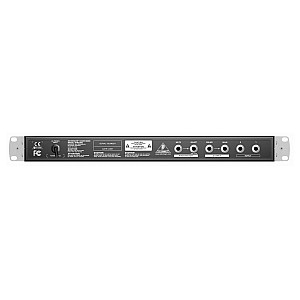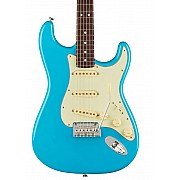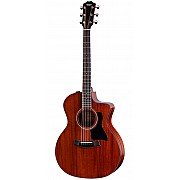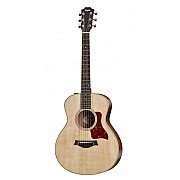 Monday-Friday : 09.00 - 18.00 , Saturday : 09.00 - 15.00 wib
Monday-Friday : 09.00 - 18.00 , Saturday : 09.00 - 15.00 wib -

SECURE STORE
Official shop,Original and Warranty.
-

FAST SHIPPING
WITHIN 1 HOUR *
-

CALL US
021-6501012 / 65306112
-

ADDRESS
JL.SUNTER MAS BARAT 1 BLOK H.9 NO.4 JAKARTA UTARA
Shopping Cart
0 item(s) - Rp.0,00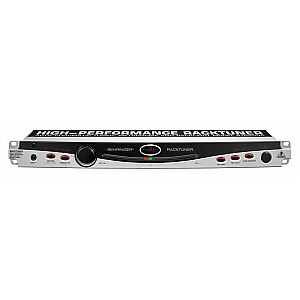
Spesifikasi Behringer BTR2000 2 Channel RACKTUNER and Metronome
Behringer BTR2000 2 Channel RACKTUNER and Metronome
We know that intonation can make or break a performance, so stay in tune with the Behringer Racktuner BTR2000 auto-chromatic tuner. Whether you play guitar, banjo, or bass, the BTR2000's 11 different tuning modes ensure that it can tune just about any stringed instrument that you throw at it. You can tune your instrument by plugging directly into the BTR2000 and using its built-in microphone, or simply tune to a reference tone. With a built-in metronome and rack lights, the multifunctional Behringer Racktuner BTR2000 auto-chromatic tuner will make a useful addition to your rack.
Behringer Racktuner BTR2000 Auto-chromatic Tuner at a Glance:
- 11 different modes offer amazing tuning versatility
- Ample I/O maximizes usefulness
- Behringer - a brief history
11 different modes offer amazing tuning versatility
You can tune just about anything with the Behringer Racktuner BTR2000 auto-chromatic tuner. Press the Mode/Fine button to select from 11 different tuning modes: Chromatic, Guitar, Bass, Baritone, Banjo, Ukulele, Open D, Open E, Open G, Open A, and DADGAD. You can tune your instrument by plugging directly into the BTR2000 and using its built-in microphone, or simply tune to a reference tone. The BTR2000 can even be calibrated 12Hz higher or lower than 440Hz, making it ideal for tuning orchestras.
Ample I/O maximizes usefulness
You can plug your instrument into the 1/4" input jack on the front of the Behringer Racktuner BTR2000 auto-chromatic tuner, or plug two instruments into the dual 1/4" input jacks on the rear of the unit. A 1/4" jack allows you to output metronome and reference tone sounds, while a second 1/4" jack allows you to output either the sounds generated by the BTR2000 and the instrument signal, or the instrument signal alone. You can also connect a footswitch to the BTR2000 for muting its main output, toggling between inputs, or activating/deactivating its metronome.
Behringer - a brief history
Uli Behringer showed an interest in music technology design at a young age, building his own synthesizer by the age of 16. In 1982, Uli began studying sound engineering and classical piano at the Robert Schumann conservatory in Dusseldorf, Germany. Uli's defining moment came when he was repairing a signal processor made by a high-end manufacturer. Despite the processor's expensive price tag, Uli realized that its internal components could be bought for a fraction of the cost. Being a strapped-for-cash student, Uli began building his own signal processors. Before he knew it, other students began requesting equipment from him. In 1989, after being bombarded with more orders than he could handle by himself, Uli created Behringer, Inc.
Behringer Racktuner BTR2000 Auto-chromatic Tuner Features:
- 11 different tuning modes offer amazing versatility
- Built-in microphone for use with acoustic instruments
- Manual or automatic A-tone standard pitch calibration for flexible tuning
- Adjustable resolution of the LED bar for precise and/or user-defined tunings
- Mute function for direct signal muting during tuning
- Built-in metronome helps you stay on the beat
- Manual Tap tempo function lets you work on-the-fly
- Additional 1/4" TS output for metronome click/reference tone allows for monitoring and practice applications
- Integrated rack lights with high-power LEDs let you see what you're doing
- True hardware bypass for highest signal integrity between input and output
Behringer BTR2000 2 Channel RACKTUNER and Metronome
Spesifikasi Behringer BTR2000 2 Channel RACKTUNER and Metronome
Behringer BTR2000 2 Channel RACKTUNER and Metronome
We know that intonation can make or break a performance, so stay in tune with the Behringer Racktuner BTR2000 auto-chromatic tuner. Whether you play guitar, banjo, or bass, the BTR2000's 11 different tuning modes ensure that it can tune just about any stringed instrument that you throw at it. You can tune your instrument by plugging directly into the BTR2000 and using its built-in microphone, or simply tune to a reference tone. With a built-in metronome and rack lights, the multifunctional Behringer Racktuner BTR2000 auto-chromatic tuner will make a useful addition to your rack.
Behringer Racktuner BTR2000 Auto-chromatic Tuner at a Glance:
- 11 different modes offer amazing tuning versatility
- Ample I/O maximizes usefulness
- Behringer - a brief history
11 different modes offer amazing tuning versatility
You can tune just about anything with the Behringer Racktuner BTR2000 auto-chromatic tuner. Press the Mode/Fine button to select from 11 different tuning modes: Chromatic, Guitar, Bass, Baritone, Banjo, Ukulele, Open D, Open E, Open G, Open A, and DADGAD. You can tune your instrument by plugging directly into the BTR2000 and using its built-in microphone, or simply tune to a reference tone. The BTR2000 can even be calibrated 12Hz higher or lower than 440Hz, making it ideal for tuning orchestras.
Ample I/O maximizes usefulness
You can plug your instrument into the 1/4" input jack on the front of the Behringer Racktuner BTR2000 auto-chromatic tuner, or plug two instruments into the dual 1/4" input jacks on the rear of the unit. A 1/4" jack allows you to output metronome and reference tone sounds, while a second 1/4" jack allows you to output either the sounds generated by the BTR2000 and the instrument signal, or the instrument signal alone. You can also connect a footswitch to the BTR2000 for muting its main output, toggling between inputs, or activating/deactivating its metronome.
Behringer - a brief history
Uli Behringer showed an interest in music technology design at a young age, building his own synthesizer by the age of 16. In 1982, Uli began studying sound engineering and classical piano at the Robert Schumann conservatory in Dusseldorf, Germany. Uli's defining moment came when he was repairing a signal processor made by a high-end manufacturer. Despite the processor's expensive price tag, Uli realized that its internal components could be bought for a fraction of the cost. Being a strapped-for-cash student, Uli began building his own signal processors. Before he knew it, other students began requesting equipment from him. In 1989, after being bombarded with more orders than he could handle by himself, Uli created Behringer, Inc.
Behringer Racktuner BTR2000 Auto-chromatic Tuner Features:
- 11 different tuning modes offer amazing versatility
- Built-in microphone for use with acoustic instruments
- Manual or automatic A-tone standard pitch calibration for flexible tuning
- Adjustable resolution of the LED bar for precise and/or user-defined tunings
- Mute function for direct signal muting during tuning
- Built-in metronome helps you stay on the beat
- Manual Tap tempo function lets you work on-the-fly
- Additional 1/4" TS output for metronome click/reference tone allows for monitoring and practice applications
- Integrated rack lights with high-power LEDs let you see what you're doing
- True hardware bypass for highest signal integrity between input and output
Write a review
Your Name:Your Review:
Note: HTML is not translated!
Rating: Bad Good
Enter the code in the box below:


